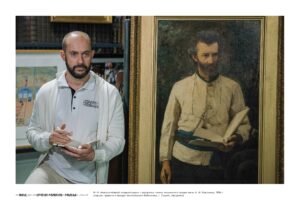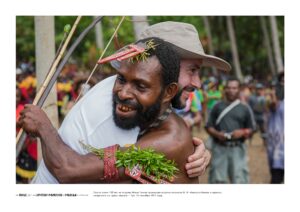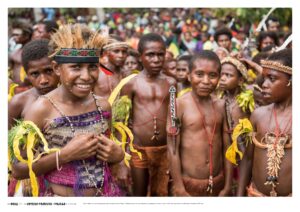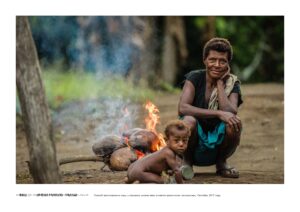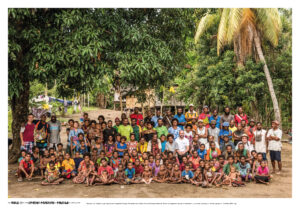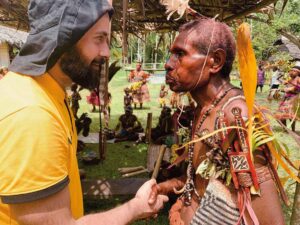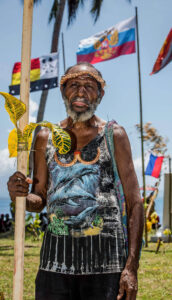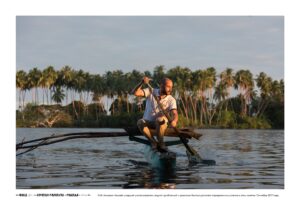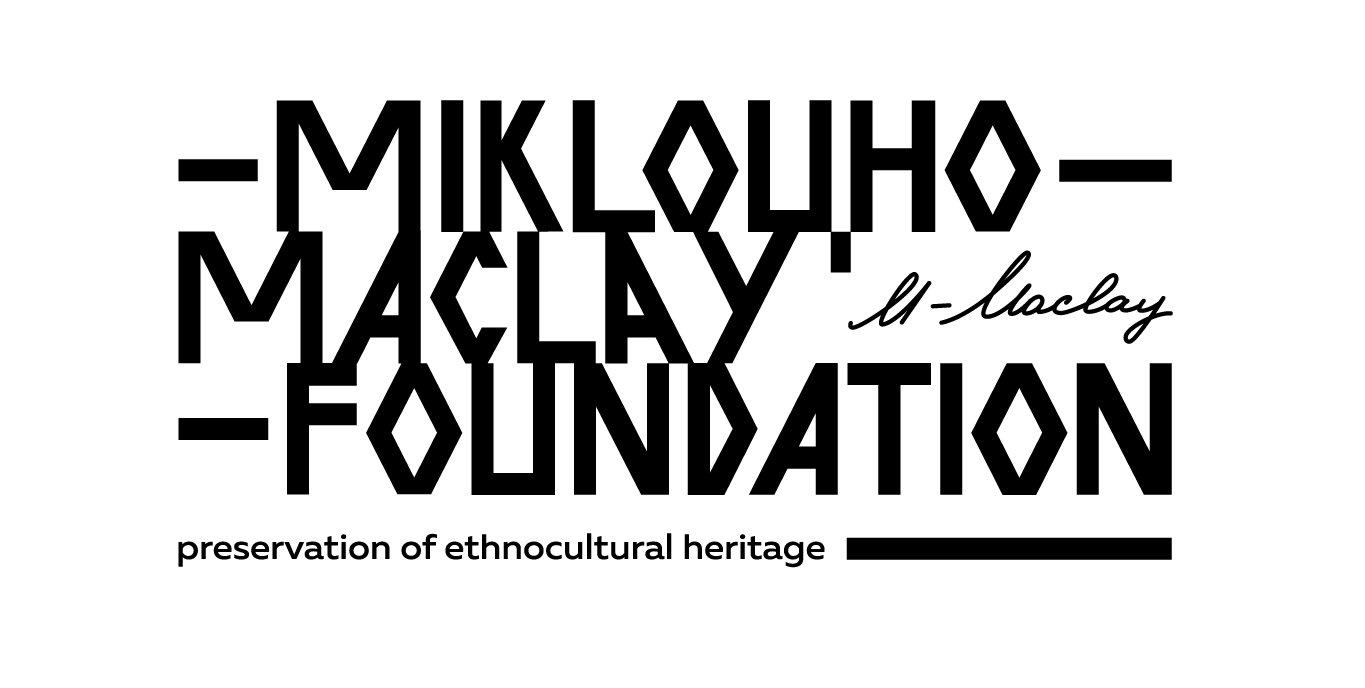Russian expeditions to Papua New Guinea in 2017 and 2019: a new stage in the development of Russian ethnographic studies of Oceania.
After the Soviet expeditions of the 1970s, there was a long period of "lull" in terms of field ethnographic work both on the Maclay Coast and in Oceania as a whole. At the beginning of the XXI century, there were several visits by Russians to the shores of Astrolabe Bay, but no comprehensive expeditions were organized. The situation changed only in 2017, when the Miklouho-Maclay Foundation for the Preservation of Ethno-Cultural Heritage organized and conducted an expedition to the Maclay Coast. The expedition was led by N. N. Miklouho-Maclay Jr. (Director of the Foundation), a descendant and full namesake of the great Russian scientist.
The expedition team also included: I. V. Chininov, a research fellow from the Center for Asian and Pacific Studies of the N. N. Miklouho-Maclay Institute of Ethnology and Anthropology of the Russian Academy of Sciences; A. A. Lebedeva, a research fellow from the Department of Australia, Oceania and Indonesia at the Peter the Great Museum of Anthropology and Ethnography (the Kunstkamera) of the Russian Academy of Sciences; D. I. Sharomov, expedition photographer.
On 11 September 2017, the expedition team departed from Moscow to Sydney, but they had to stay in the city for several days due to flight delays, cancellations, and visa problems. As a result, the expedition team did not arrive in Madang until September 16, Papua New Guinea's Independence Day. There, catholic missionary S. Tsegler from Irkutsk (Russia) joined the team as an interpreter from the local language Tok Pisin. On the same day, they sailed on P. Barter's vessel (a prominent public figure and statesman, friend of the expedition leader) to Garagassi Point, the place where Miklouho-Maclay had gone ashore in 1871. The arrival of the guests from the distant country of Miklouho-Maclay was an incredible event for the locals; they were informed in advance that the descendant of their great and revered white brother was the leader of the expedition. A crowd of about three thousand people from all the surrounding villages gathered on the shore, waiting for people from the other world to arrive. When the members of the Russian expedition disembarked, the locals (Papuans) gave a grand spectacle with songs, dances and pantomimes. They hoisted the Russian flag on the place where the hut of the great traveler had been built, sang the Anthem of the Independent State of Papua New Guinea. They performed the first meeting of N. N. Miklouho-Maclay with Tui. The role of the Russian scientist was played by his descendant and the leader of the expedition (similar performances were made by the Bonguans for the Soviet expeditions members in the 1970s). At the end of the event, the expedition members were accompanied to Gorendu village and accomodated in one of the family huts, where they were to live for a week, until their departure from the Maclay Coast. In addition to Gorendu, the expedition members visited the neighboring villages of Bongu and Gumbu.
During the fieldwork it turned out that most of the local (Papuan) buildings retained the same traditional character as in the times of the Soviet expeditions. Almost all of them were built on stilts (this tradition originated in this region at the end of the XIX century), their other construction features also remained unchanged, as well as the materials (the roof is necessarily covered with saga palm leaves, the walls are made of split bamboo, etc.). A more detailed study of the local (Papuan) way of life revealed many other firmly kept elements of traditional material culture. They use mats woven of coconut leaves, clay pots (made in Bilbil village), woven bags (worn by men and women), and various decorations.
During the festivities, many indigenous people (Papuans) dress in traditional costumes, which have not changed much since the time of Miklouho-Maclay (except that there is significantly less head feathered decoration due to the impoverishment of local fauna). Performing the old songs and dances, the locals (Papuans) necessarily accompany hand wooden drums – okam. Also, they use signal shells, and in the villages of Bongu and Gumbu, slotted signal gongs – barum. All this suggests that the villagers cherish many of their traditions, despite the increasing penetration of the objects of the modern Western world. Their distinctive culture has not completely dissolved under the pressure of innovation, but is in harmony with them, which, at times, acquires very bizarre images. In general, the Bonguans still retain much of their traditional culture, and modern elements are organically superimposed on the way of life without completely transforming it. Moreover, many Bonguans are very reverent about their ethnocultural identity and do their best to instill it in the younger generation. Therefore, it is safe to say about the living cultural heritage of the Bonguans.
N. N. Miklouho-Maclay Jr. collected the legends that have been passed down from generation to generation by village Elders about his ancestor since the XIX century. The stories are strikingly similar to the diary notes of the outstanding scientist, and some facts have forever understood that for local residents Miklouho-Maclay was almost a deity, Tamo Boro Rus – the great Russian man forever left a mark in their hearts.
On September 20 (the day N. N. Miklouho-Maclay first went ashore in Astrolabe Bay in 1971) near Garagassi Point, a significant event took place - a teleconference between Moscow and the Maclay Coast. All the necessary equipment was brought from Madang. It should be noted that it was the first time in the history of the two countries that the teleconference took place and the Russians could see with their own eyes the distant Maclay Coast. Communication in these places does not allow to carry out teleconferences, but, thanks to the equipment, it was possible to strengthen the signal to communicate with Russia from the jungle. This event was attended by the first Prime Minister and actually the founder of the Independent State of Papua New Guinea – Michael Somare. His arrival caused a real furor among the locals, as he had never visited these lands before, and the reverence for the former leader is so great that he is still carried on a palanquin by several tall and stout men. Michael Somare visited the Maclay Coast at the invitation of Miklouho-Maclay Jr., he paid his respects to the descendant and to all the expedition members, and expressed his desire to cooperate with Russia. On the occasion of such an event, the locals (Papuans) of the surrounding villages again staged a sumptuous feast with songs, dances, and pantomimes. One of these pantomimes showed the famous episode when N. N. Miklouho-Maclay presented the Papuans with two bull calves, and they fled into the forest, after which the Papuans organized a hunt for them (in this pantomime they used only one bull calf). This was another confirmation that the Russian scientist and his stay among the Bonguans have become an integral part of local folklore. The Russian scientists left Gorendu on September 22; the next day the expedition team visited Bilbil village, where the memory of N. N. Miklouho-Maclay was also alive. In the past, the Bilbil people inhabited a small island of the same name about 2 km from the coast of New Guinea. But after the rebellion against the German colonial authorities in 1912, they were relocated to the coast of New Guinea, where they founded a village also named Bilbil. In the past, this Austronesian-speaking people developed an extensive trading system in which they occupied a central place, being skilled shipbuilders and first-rate potters. Their pottery was in demand in many villages of the Maclay Coast. Today, most of their pottery is sold to tourists.
After Bilbil, the expedition team returned to Madang and the next day flew to Port Moresby. There the team had an important meeting with local scientists and professors of the University of Papua New Guinea, the main educational and scientific institution of the country. Then the team left for Sydney, from where the Russian ethnographers flew to Moscow, and the expedition leader stayed in Australia for a few more days to establish Russian-Australian relations in the Maclay studies.
The results of the expedition were enormous. Extensive material on the material culture of modern Bonguans was collected, a unique collection of household items identical to those collected by Miklouho-Maclay in the XIX century, which have high historical, cultural, ethnographic value of world-scale art and everyday life, many high-quality photographs were made, and the resulting documentary film "The Man from the Moon" was successfully broadcast on Russian TV Channels. On the return to Moscow, articles in scientific journals were published, an album with many bright and colorful illustrations was released, a full-length documentary film about the expedition was made. In addition, 35 photo exhibitions were arranged in several Russian cities, reaching more than 15 thousand people who visited it in the first year alone.
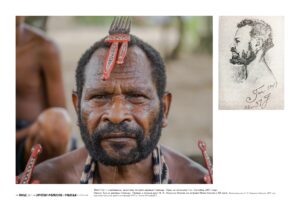
From that moment the true popularization of ethnographic studies of Oceania and Maclay studies began in Russia. The project "Miklouho-Maclay XXI century. Revived History" reached more than 14 million Russians in the first year alone, who learned about the revival of research in Oceania. In addition, economic ties between Russia and Papua New Guinea began to develop. The Miklouho-Maclay Foundation held presentations for Russians and New Guineans "Russia and Papua New Guinea - Prospects for Cooperation". These historic meetings were held with the participation of the Ambassador of the Ministry of Foreign Affairs of the Russian Federation and the Ministry of Economic Development of the Russian Federation.
In late April - early May 2019, another expedition to Papua New Guinea took place, organized by the Miklouho-Maclay Foundation for the Preservation of Ethnocultural Heritage.
Its President, N. N. Miklouho-Maclay Jr., was the leader of the expedition. This time the expedition included many more people and scientists: there was ethnologist I. V. Chininov, and in Port Moresby, O. Temple, a linguist from the University of Port Moresby (a former Soviet citizen), joined the expedition team. Before arriving at the Maclay Coast, the team visited Hanuabada, a village of the Austronesian-speaking Motu people, located west of Port Moresby. The Motu people were also formerly renowned potters and traders, making their hiri (trade voyages) in multihull sailing vessels lagatoi along the southern coast of New Guinea, exchanging pottery for sago and tree trunks (to make new boats). This was followed by a visit to the multi-ethnic Koki community east of Port Moresby. On the Maclay Coast the expedition members were again accommodated in Gorendu village (in that part of the village which is now called "Maclay village"), but also visited the villages of Bongu and Gumbu. In each village guests from Russia were greeted with festive performances with songs and dances.
I. V. Chininov researched the contemporary economic life of the Gorendu villagers, and O. Temple conducted linguistic research of the Bongu language. The expedition stayed in Gorendu from April 27 to May 4. Miklouho-Maclay Jr. was filming a documentary about everyday life of the locals (Papuans) of the Maclay Coast and the legendary descendant of the Papuan Tui, who first met Miklouho-Maclay in the XIX century and became his friend.
After that, the team returned to Madang, and on May 5 it visited Bilbil village. This time the Bilbil people took the Russian guests by motorboat to their former homeland, Bilbil Island. Now there is no permanent population there, but at certain times of the year, Bilbil people visit this island for Initiation ceremonies. Returning to Madang, the team visited the local university, where an informative meeting was held with the students. Back in Port Moresby, the expedition team visited the University of Port Moresby to enhance educational relations between the two countries.
The results of the second expedition were also significant. Valuable material was collected on the economic way of life (farming, fishing and hunting) and the current state of the Bonguan language; a documentary film was made about various aspects of life of the villagers of Gorendu, Bongu, Gumbu, Bilbil, Hanuabada and Koki community; valuable historical stories about N. N. Miklouho-Maclay in Gorendu were set down; economic relations between Russia and Papua New Guinea enhanced; an educational project on establishing a Russian Cultural and Informational Center in Port Moresby and Madang settled.
In fact, Maclay's expeditions in the XXI century revived not only scientific research of the Russians in the region, but also established cultural, humanitarian, and economic relations between the two countries.

